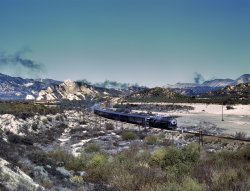
MAY CONTAIN NUTS

Search Shorpy
SHORPY ART

Framed or unframed, desk size to sofa size, printed by us in Arizona and Alabama since 2007. Explore now.
Join and Share
Ad-Free Shorpy
Shorpy is funded by you. Patreon contributors get an ad-free experience.
Learn more.

Recent comments
- Party of Eight?
- Good choice
- Recent view
- Hudson’s Big Store
- Say what??
- Grapes?!
- Just a Great photograph.
- A Beautiful Moment
- Such joy
- Bethune-Cookman University today
- Yellow sky at morning
- Side Winder
- Air Quality?
- Sojourner Truth riot
- None were so blind(ed)
- The less famous sister
- Good ol' days?
- Rise and Fall
- Goo Goo Ga Joob
- Ticket Retention
- Not the only one
- Vagaries of War
- Killed by Amtrak
- Back to the Future
- Wanted --
- If you can't stand the light
- Centralized Traffic Control, I believe
- What's really happening
- Heckuva remote control!
- Sometimes — Things Go Bump!
Member Photos
The Shorpy
Print Emporium
Print Emporium
Search Shorpy
Search results -- 30 results per page
- Zenith City: 1905
- ...
Let us venture back to a time When Railroads ruled the Earth. Are they birthing Orcs in that roundhouse?
The ... picture.
(The Gallery, Boats & Bridges, DPC, Duluth, Railroads) ... Posted by Dave - 08/13/2012 - 6:55pm -
![Zenith City: 1905 Duluth, Minnesota, circa 1905. "Elevators and harbor," along with a view of the Incline Railway and many other points of interest, make up our daily dose of Duluth. Detroit Publishing Company glass negative. View full size.
The Old BallgameAre those guys playing baseball in the lower right? They're spread out like they're playing something very similar. (Click to enlarge.)
Let us venture back to a timeWhen Railroads ruled the Earth. Are they birthing Orcs in that roundhouse?
The same scene today.Despite all the changes, this scene is still recognizable.
Alluring Alliteration "Daily dose of Duluth." Gotta love it.
ImprovementsDuluth really looks much, much better today!
Rail lineA mid 1880s source cites the "St. P.&D. and N.P. Round House."
That's the biggestroundhouse I've ever seen! Any bigger and it wouldn't have a way to bring locos in.
Here is a shot of a current Duluth roundhouse from above (Google).
Re: The Old BallgameYep. I think we've stumbled onto some Duluth-variety hardball. And from the outfield alignment, we can only guess our batter is not a pull hitter.
Baseball?Good catch. Who's on second?
This is why we look at the ShorpyAnother truly amazing photo.
It's deeply three-dimensional:
From the busy shirtwaist lady in the foreground, to the slouchy men hanging out by the steam laundry, to the (obviously) baseball people, to the infernal roundhouse, to the ships in the harbor...
Visually they're all stitched together, front to back, by the power poles: you can see individual insulators on the nearest ones, behind the Clarendon Hotel (New!), but they merge into infinity as they march to the shining harbor.
This is surely one of Shorpy's best. Apart from the swimsuit girls, of course.
Duluth & Iron RangeThe boxcars lower left look like they might have "D.&.I.R." on them. That would make it the Duluth & Iron Range, which merged in 1938 to become the D.M. & I.R.
There are some more boxcars above those D&IR ones that look like they might be Great Northern. But the owner of the roundhouse is definitely not clear.
Re: What's MissingIndeed, they probably walked to and from work. I grew up in Beech Grove, Indiana, home to a large repair yard for Penn, Penn Central and Amtrak that dates back to 1910 or a little before.
In the early '60s it was astonishing to see hundreds of workers in overalls, kerchiefs and the traditional engineer cap (with its distinctive narrow gray striping) as they walked westward down Main Street after work. Each carried a lunch pail and most seemed to have a newspaper under the arm.
They would crowd the sidewalks on both sides for several blocks, from a distance looking something like a pair of giant centipedes. Not surprising, Main Street was also lined with taverns which surely enticed many men to stop for a quick beer as they made their way home.
Big SkyCan anyone comment on why many of these old photos have so much "head room"? Photographers today compose their shot to get the most matter and keep the sky to a minimum. (Not to mention having to deal with the contrast ratio.)
What's Missing!!!If this photo were made today there would be employee cars parked everywhere. That roundhouse surely employs quite a number of people.
In 1905 I assume that most folks either walked to work, like the folks walking on the viaduct, or rode the streetcar. There isn't even a horse and buggy to be seen. It does look like there might be a couple of streetcars way down the street.
For the birdsI like the big bird house in the back yard of the place across the street from A. Larson's "General Arthur" store, or whatever that says. It looks just as ramshackle as the rest of the buildings. Being on a crookedstump doesn't help -- the eggs'll roll out!
Unfortunate use of quotes"The Best" Beer in Milwaukee, eh? For some reason I don't believe you. Why'd you have to use the quotes, huh?
The RoundhouseLots of comments about the roundhouse, and it is a big one: 36 stalls if I count right. It's interesting to see photos of such buildings when they were comparitively new as opposed to how they looked by the end of the steam age. Question I have is which railroad did it belong to? Has to be either C&NW or DM&IR, but I can't tell by the locomotives parked nearby as I'm not an expert on either road's power. I'm guessing C&NW, a far larger road who would need a roundhouse of this size.
Selz Royal BlueFantastic details. This world of busy, grimy character has a real appeal for me. And what a great opportunity to see newly-painted side-of-building advertising in all its glory. Today one sees mostly faded "ghost" images. Across the way from Miller Beer, Selz Royal Blue was a shoe brand advertised all over the country. This ad in the Arizona Journal-Miner is from 1905.
Rices PointThe rail yard is the Northern Pacific Railways's Rices Point Yard and roundhouse. The elevated tracks on the left are Great Northern Railway.
Actually, that looks like cricketAs to the ballgame being played at the right, the people don't seem arrayed correctly for baseball, but it looks like it would work for cricket, which, as I understand it, was actually played in parts of the U.S. at the time.
[Duluth -- "Cricket Wicket of the Unsalted Seas." - Dave]
Iron AgeA portion of the fancy iron railroad bridge off in the distance still exists -- the first truss span -- visible on Google Maps and Street View from the freeway bridge next to it (its concealed by the freeway bridge in the modern view in the first comment). Its the only landmark I can find that exists from the original picture.
(The Gallery, Boats & Bridges, DPC, Duluth, Railroads)](https://www.shorpy.com/files/images/4a06777a.thumbnail.jpg)
- Plane No. 7: 1900
- ... Boonton.org .
(The Gallery, Boats & Bridges, DPC, Railroads) ... Posted by Dave - 12/15/2022 - 12:28am -
![Plane No. 7: 1900 Boonton, New Jersey, circa 1900. "Top of plane, Morris and Essex Canal." 8x10 inch dry plate glass negative, Detroit Photographic Company. View full size.
Read if so inclinedI didn't know this, so maybe others don't too:
A [canal] inclined plane is a type of cable railway used on some canals for raising boats between different water levels. Boats may be conveyed afloat, in caissons, or may be carried in cradles or slings.
This would be the long way roundAt least it would be today. Between 1824 and 1924 the Morris Canal served Boonton's iron industry between Phillipsburg and Jersey City. Iron crossed over the Jersey Hills by use of 23 lift locks and 23 inclined planes. Thank you, Kiwanis.
Painting of the Boonton LockI am so very happy to see this image Shorpy-fied!
My grandparents lived two blocks from the Boonton lock and plane. He, F. C. Wells, was a Manhattan architect and painter. In the 1940s (or maybe '50s) he created a rather surreal image of the "guard lock" at Boonton (attached). I don't know for certain, but I think he painted this collage of imagery over another painting -- as suggested by the church turrets in the background and the forested mountain on the right.
D&H CanalVery cool. I remember my father mentioning it a few times, he was born in 1917 in Irvington. Up here in Ulster County there are a couple of museums celebrating the Delaware and Hudson Canal, roughly the same time period, running from Pennsylvania coalfields to the Hudson River. Coal then moved on barges down the Hudson. It was built in ten years. There's an inland town along it’s its length called Summitville because it was the highest point on the canal. This being a more rural area, there are lots of parts remaining.
+120 YearsThe building on the left with the bay windows is still standing:
The inclined plane started by the intersection of Main Street and School Road. You can see where the canal and inclined plane were on this old map of Boonton.
Lots of great then-and-now photos (including another view of the top of the plane) at Boonton.org.
(The Gallery, Boats & Bridges, DPC, Railroads)](https://www.shorpy.com/files/images/SHORPY-4a07225a.thumbnail.jpg)
- The Underwear Railroad: 1906
- ... and histories of all of Cincinnati's inclined plane railroads.
Gone forever This was Cincinnati's last and probably most ... )
(The Gallery, Cincinnati Photos, DPC, Railroads, Streetcars) ... Posted by Dave - 08/12/2012 - 3:21pm -
![The Underwear Railroad: 1906 Cincinnati, Ohio, circa 1906. "Mount Adams incline." A closeup of one of Cincy's famous incline railway lines, and of a lesser-known clothesline. Also: Moxie! 8x10 inch dry plate glass negative, Detroit Publishing Company. View full size.
Mount Adams modelA fellow in Mount Adams has made a detailed model:
http://notetaker.typepad.com/incline/
And another photo showing how cars arrived at the bottom:
The foreshortening of the Shorpy photo made me question how the cars met up with the street level. The above link explains that a bit better.
I couldn't fathom the smooth rails working until I realized the two cars are linked by cable and counterbalance each other - much like elevators (used to?) do.
Also: Moxie!Dave wasn't going to let us Shorpyites overlook a Moxie sign two weeks in a row. I like Moxie.
Streetcar track gaugeIt's not only the foreshortening that makes the streetcar tracks look rather far apart. The Cincinnati Street Railway used a broad track gauge of 5 feet 2 inches in those days.
Angel's FlightLooks alot like Los Angeles.
Which came firstthe tracks, or the houses they rub right by? And can someone tell me how the cars made it up that incline? Were they towed up?
What firetraps!How all those wooden shacks were kept from all burning down I'll never know. Most were heated with stoves.
You got a lot o' Moxie palFellow Shorpsters correct me if I'm wrong but I believe the Moxie soft drink brand pre-dated CocaCola by several years at least.
That photo is vivid and transfixingEvery element of it shows the complete complexity of human endeavor and effort. Human care and attention went into every atom of that shot -- from the placement of the posters along the fences, to the cobbles in the street, to the stitches in the long drawers. Is any of it left at all?
More infoThere's a book covering this called "Cincinnati; City of Seven Hills and Five Inclines" including photos, drawings and histories of all of Cincinnati's inclined plane railroads.
Gone foreverThis was Cincinnati's last and probably most famous incline. Every once in a while someone suggests rebuilding it, since the original right of way is largely intact. Main problem: the area at the base of the incline is now a spaghetti bowl of interstate highway concrete. The track supports are still easily seen in the google satellite view.
View Larger Map
That'll stop 'emIf you look closely you'll see a pair of I-beams rising vertically out of the pavement directly between each pair of tracks. These created a simple-but-effective barrier to trolleys accidentally rolling forward into the abyss when no counterbalance platform was in the station.
The one on the left looks as if it actually did its duty a time or two.
Logistics, pleaseI still don't see how the cars met up with the street level tracks. What about that fence and what appears to be a street lamp directly in front of it? Does all that stuff fold down?
And shouldn't that little girl get out of the way?
[The "inclinator" (outlined in red) carries the car up and down. I also outlined one of its wheels. When it gets to the bottom, the streetcar is level with the street and moves onto the tracks in the foreground. - Dave]
Streetcar EscalatorThe attentive viewer will note that the sturdy railings protecting the ends of the street-mounted tracks can be lowered when the "elevator" approaches street level, as evidenced by the rollers and center thrust pillar. The conductor hooks his trolley onto the wire, and the car may roll off the inclinator and onto the street, as shown in the submitted photo.
Re: Which came first See the three cables in the middle of the track behind the car at the bottom. Those pull the car up and let it down. Most of the power comes from gravity pulling the car that is on the way down the incline. Its weight and movement help pull the upward bound car. The engine supplying any extra power needed is up in the building at the top of the hill, probably steam at that time. Both cars are basically attached to the same cables wrapping around a wheel at the top.
Moxie Lives!Moxie lives on in the far north of New England. I can't imagine why. My grandmother used to drink this stuff when I was a kid and it's vile. For extra vileness, she used to mix it 50/50 with milk.
I was shocked when I saw it for sale on a recent trip through Maine. I hadn't seen Moxie in a store for 30 years.
Up and DownMore about all five of Cincinnati's inclines here.
FunicularsIn Europe we call an inclined railway a funicular. This one had two counterbalanced platforms linked by three cables (two hosting and one safety cable). Steam engines (see the chimney) were used to power incline. There were siz I-beams, two between the tracks at the bottom station and the same at the top station and one I-beam on each platform. The normal position of all these I-beams was up. Each I-beam was counterbalanced and automatically dropped down when the platform reached the end of the track.
University of ShorpyI've learned more by visiting Shorpy than any history book I read in school. Thanks!
On Top of the InclineThis is an exceptional photo. Fascinating. My mother and her parents often took the Mount Adams incline to visit the famous Rookwood Pottery plant located on top of the incline hill. Mount Adams is still a wonderful place to visit via a walking tour. Some of these tall narrow buildings still exist alongside and in between newer structures on the Mount Adams hillside. It remains one of the cultural pockets of Cincy. For anyone interested, Rookwood Pottery relocated in 2009 from Clifton to the newly rejuvinated Over-the-Rhine historical downtown neighborhood. Cincinnati has a very active preservationist association. This city is alive with rejuvinating historical areas. Go Cincy.
Double-wire overhead"The conductor hooks his trolley onto the wire".
The conductor would place BOTH trolley poles, one on each wire. Cincinnati used a negative return wire instead of using the track, so each car had four trolley poles.
I rode the Adams Incline It closed in the 40s but I remember it well. In the summer months they would use open air cars with great views of downtown. There were several inclines in Cincy but they disappeared when buses could finally master the city's many steep hills. By 1950 all the streetcars had been replaced by buses.
Yes, Moxie!Moxie is the official soft drink of the State of Maine (as of May 10, 2005). If you're going to be in Maine in July, check out the Moxie Festival. (www.moxiefestival.com)
(The Gallery, Cincinnati Photos, DPC, Railroads, Streetcars)](https://www.shorpy.com/files/images/4a13292a.thumbnail.jpg)
- Carson City: 1940
- ... Nice view of a stub switch, not uncommon on narrow gauge railroads, but V&T was standard gauge. That's V&T locomotive #26, a ...
Stub switches are no longer legal on interchange railroads in the USA. They are not as safe as a 'knife' switch because a train ... Posted by Dave - 02/24/2018 - 7:20pm -
![Carson City: 1940 March 1940. "Operating switch at railroad station. Carson City, Nevada." Photo by Arthur Rothstein for the Farm Security Administration. View full size.
Oh yes, it's possibleThis car probably goes into Mexico and back, so liters=litros
Target practice.Looks like the day marker was used as a target on one or more occasions.
Stub SwitchStraight up Straight ahead.
Is it possible ...that oil tank car is measured in both litres and gallons??
[Capacidad 40436 litros (liters) does indeed = 10862 gallons. -tterrace]
Virginia & TruckeeNice view of a stub switch, not uncommon on narrow gauge railroads, but V&T was standard gauge. That's V&T locomotive #26, a 1907 Baldwin 4-6-0. She was destroyed in an engine house fire in 1950.
Voyage à TroisNever seen a three-way track switch before. That's some clever engineering.
A modern 3-way stub switchActually it is no more complicated to layout a three-way stub than it is to lay out a single switch--just twice as much work. You basically work off of a set of tables in a a book.
Stub switches are no longer legal on interchange railroads in the USA. They are not as safe as a 'knife' switch because a train going through a switch set incorrectly will derail and drop the lead cars onto the ties. (an experience I do not want to repeat!)
Here is an example of a modern 3-way stub located at the Railroad Museum at Ardenwood, in Fremont, CA on a 3 ft gauge railroad. The switch stand is a harp stand located just out of the picture on the left (you can see the target),
(The Gallery, Arthur Rothstein, Railroads, Small Towns)](https://www.shorpy.com/files/images/SHORPY-8b19825a.thumbnail.jpg)
- Edwards Depot: 1936
- ... except for some fainter vegetation.
(The Gallery, Railroads, Small Towns, Walker Evans) ... Posted by Dave - 01/12/2023 - 3:07pm -
![Edwards Depot: 1936 February 1936. "View of railroad station. Edwards, Mississippi." 8x10 inch nitrate negative by Walker Evans for the U.S. Resettlement Administration. View full size.
Vertical LinesWhat are the Vertical Lines suspended from the Horizontal overheads. I suspect a Curtain Array Antenna of some type (?)
[See above. - Dave]
Thanks. Interesting
TelltalesI spot three of them, one over each track.
What a scene.WOW! That's a model railroader's prototype just waiting to be built to scale.
Without much to go onI believe this is the area in Walker Evans's 1936 photograph. I could not identify any buildings still there today. The railroad tracks bear right heading west and are straight heading east.
[W.E. was shooting from the Magnolia Street bridge. The white building with the brick insert is at far left in his photo. - Dave]
Dave, thanks for using a better reference point than I had (I was down by the parked cars at left). Your spot also lets me recommend everyone spin their street view around and appreciate the old homes along Magnolia.
Those "Vertical Lines"As delorthlo states, they are telltales, to warn carmen on the roofs of cars of an approaching tunnel or other obstacle.
Zero stoplights, three pagesIs how someone might have described Edwards in 1936; the "pages" of course being the Sanborn fire maps (In short, a pretty small place; but a step up from one page, and obviously two steps up from not being mapped at all).
The map tells us Edwards seems to have been a more interesting place than it is now: for example the brick buildings beyond the station were but two of a long stretch of such structures -- "Main Street" in both name and fact -- and out of the picture to the right the station fronted on a town square; it doesn't impress much today. One suspects Edwards' opportunity to need a stoplight has passed by.
O' Brother, Where Art Thou.From the crossing looking towards the bridge is from the move O' Brother, Where Art Thou? At the end of the movie this shot is used. Larry is correct, a modeler's dream. On my list to include in my layout.
Both sides of the tracks... look equally bad.
Order BoardThe 2 faced lower quadrant semaphore protruding from the roof of the combined passenger and freight station was not used to control train movements. Instead, it is an "Order Board", controlled by the station agent via vertical rods, used to notify train crews that they needed to pick up train orders, called "flimsies", since they were written on tissue paper to create multiple carbon copies. Depending on the importance of the train order, they could either be picked up on the fly by spearing a thin wooden hoop with your arm, or safety related orders required the crew to stop and sign for the orders. In either case, copies of the orders were delivered to both the engine crew(s) and the conductor in the caboose. The order board indicated which kind of orders they were. A double header with a caboose and pusher would require 4 copies, plus a copy for the agent's records.
Train orders are still used, issued to crews by the dispatcher via radio, with mandatory correct readback from the crew, and the radio traffic recorded in case of an incident. The crew writes the orders on a paper form in the cab.
Those telltales saved lives. In the days before portable "lunchbox" brakeman radios and diesel dynamic brakes, there were several reasons for brakemen to stand on car tops, to signal the engineer while switching around a curve, and to apply and release handbrakes on a downgrade. Incredibly dangerous to keep your balance, and step to the next car, apart from being knocked off the roof by a bridge or tunnel. Eventually, the roof walks were removed, and the ladders leading up to the roof were shortened to just be something to hold on to when riding on the end of a car while switching. Still dangerous work if you aren't alert.
I'm old enough to have seen the tail end of this era, as a kid spent many hours talking with agents in stations and manual "armstrong" interlocking towers, listening to the dispatcher's party line. Knew several crossing watchmen, who spent their days in little towers at major railroad crossings, pumping down the pneumatic crossing gates for each train. I have a small brass 2 lever frame used by the agent to control an order board.
Car IDFive Chevrolets.
TelltalesThese were to warn railroad workers on top of the cars (usually brakemen) that the train was approaching a low overhead structure, in this case the highway overpass from which the photo was taken. As railroad braking systems improved, the need for "decorating" the cars reduced, until the practice is now forbidden.
Phantom StationIn Doug Floor Plan's modern view of the area, it seems that I can see the "ghost" of that long-ago station: lighter patches of grass where buildings used to stand. I guess it's a good example of how quickly human-made constructions can disappear from view and leave no trace, except for some fainter vegetation.
(The Gallery, Railroads, Small Towns, Walker Evans)](https://www.shorpy.com/files/images/SHORPY-8c52107a.thumbnail.jpg)
- Leviathan: 1926
- ... this past year. I don't know why; I'm not interested in railroads or big machines. I keep coming back to it, though. Perhaps it's ... 1396 posed for the camera.
(The Gallery, Natl Photo, Railroads) ... Posted by Dave - 07/17/2012 - 10:13pm -
![Leviathan: 1926 Washington, D.C., or vicinity circa 1926. "Southern R.R. Co. Crescent Locomotive 1396." View full size. National Photo Company Collection glass negative.
Queen Crescent LimitedA short history of the Queen Crescent Limited.
1396, 1926
Still puffin'I have lived in Chattanooga and more than once rode on the excursion trains pulled by this locomotive! (see history link)
I must compliment Dave on the enlargements of small details in the photos. Reminds me of the movie "Call Northside 777" in which the murderer is caught because the photo lab enlarges the date printed on a newspaper held by a newsboy! Ever tried newspapers, Dave?
[Yes indeedy. - Dave]
One of your best yet.This is one of your best yet. Very handsome.
Cheers to you and the National Photo Company.
Southern ClassA Great Railway. Great class of loco: Ps4. Same as the one in the Smithsonian. WOW!!
ExcursionsAs far as excursions, you're probably thinking of Southern Ry. #4501, a freight engine, which was bought back from a shortline, and painted-and-otherwise-gussied-up to represent a passenger engine. It pulled many excursions starting in 1966. The real SR passenger steamers didn't make it past 1953 or so. (When the management realized steam excursions would be a real crowd-pleaser, the one in the Smithsonian was already "trapped inside.")
WowBravo.
Old 1396Beautiful engine absolutely beautiful! She was built 9 years & 9 months before I came along. Reminds me of the troop trains in the 1940s, heading south on the L&N Line as they passed through my hometown in central Kentucky, a little burg called Wildie in Rockcastle County. Wish I was back there now.
Greatest achievementI maintain that the steam locomotive remains mankind's greatest accomplishment.
WOWThis photo was taken in Southern Railway's yard in Alexandria, near the King Street station - if you look just to the right of the most distant power pole, you can see the George Washington Masonic Temple.
No. 1396 was one of the first 12 PS4s delivered in Southern Railway's new "Sylvan Green" paint scheme. Most were lettered "Southern" on the tender, but no. 1396 was lettered "Crescent Limited" (not "Queen & Crescent" - that refers to the Cincinnati - Chattanooga - New Orleans route, and was applied to no. 6689) and assigned to the new, all-Pullman luxury train of the same name.
Alexandria YardThe George Washington National Masonic Memorial was dedicated in 1923 but not mostly completed until 1932, so I don't believe that appears adjacent to the far telegraph pole. I believe this view is looking roughly east, with the wooden yard office to the right of the locomotive. About where the boxcars are out of view in the distance is where Hoofe's Run crossed under the tracks.
-- Frank R. Scheer, Railway Mail Service Library
Museum PieceThe same class of locomotive photographed by me in 2006 when I visited the Smithsonian's railroad section.
My favoriteThis is my favorite of the images posted on Shorpy this past year. I don't know why; I'm not interested in railroads or big machines. I keep coming back to it, though. Perhaps it's because despite my disinterest I admire this magnificent machine and the work that went into creating and maintaining it. It makes me think about traveling and I imagine how people of the time would have looked at it in awe and thought of the big cities and world beyond their own region.
Thanks Dave and crew for the work you've done and thanks to all the insightful Shorpy posters. Best wishes for the new year, and many more intriguing photos and enlightening posts.
Looking east toward Callahan StreetThis view of the Southern Railway yard in Alexandria is looking east. The Masonic Temple would be behind the photographer's left shoulder. The little yard shacks were on the other side of Callahan Street. These shacks were there as late as 1980 or so as I have a photo of them. The roundhouse was to the right of the locomotive, probably out of the picture. The building to the right may be the yard office. The Northern Virginia Model RR club occupied a building in this approximate location for about 20 years from the early '50s until the early '70s.
Herby's Ford was located to the left of the photo, on the opposite side of the Callahan Street crossing. It was built soon after WW2.
Leviathan in colorSadly there are no contemporary color images of Ps-4s in their early days, but my friend Tom Alderman of Mayretta, GA has given us an idea of what it looked like on that day in Alexandria when 1396 posed for the camera.
(The Gallery, Natl Photo, Railroads)](https://www.shorpy.com/files/images/32810u1.thumbnail.jpg)
- Little Falls: 1941
- ... trees to the middle left.
(The Gallery, John Collier, Railroads, Small Towns) ... Posted by Dave - 10/01/2022 - 1:08pm -
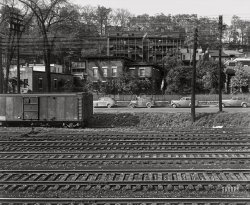
- Pensacola: 1910
- ... funnel stack indicates this was a woodburning loco.
Railroads of the deep south burned wood for fuel long after the practice was ... to the station.
(The Gallery, DPC, Florida, Pensacola, Railroads) ... Posted by Dave - 08/14/2012 - 8:21pm -
![Pensacola: 1910 Pensacola, Florida, circa 1910. "Louisville and Nashville Railway station." Where libations for the parched traveler are a mere stagger away. View full size.
Grand HatsThere are two ladies in this photo and both have nice big hats. I also particularly like the travel coat the lady on the right (facing away) is wearing.
The StationIt appears as if the old station shown in this picture was replaced by a new station in 1912. That one still stands, although it was converted to a Crowne Plaza Hotel.
Beer PerspectiveIt is an unusual way that we no longer think of beer as food.
I discovered a beer tray of the same period of the Chattanooga Brewing Company.
I have maintained for years that Beer is Food!I got a good laugh out of that one.
I imagine... that sfter sampling all of the different shops' offerings, you might start to see weird things like this!
ErgoIf beer is considered pure liquid food,I submit a bratwurst as an example of pure solid beer.
Special carCheck out that odd railcar on the right. The entire end of the car opens like a garage.Some boxcars were equipped with end doors for loading autos and such, but this car has a smokejack on the roof, indicating this was a railroad maintenance car of some sort.
Beyond that car on the upper right of the photo, is the front of a locomotive, with a smokestack from a Matthew Brady photograph. The large funnel stack indicates this was a woodburning loco.
Railroads of the deep south burned wood for fuel long after the practice was ended elsewhere.
Old DepotMy father's family is from Pensacola, so I'm always excited to see northwest Florida photos. This station, at Tarragona and Wright streets, opened in 1882. A new station (still standing) opened in 1913, just across what is now I-110, at the corner of Alcaniz and Wright.
Liquid LunchA pint or two of Guinness has been an Irish lunch for a long, long time.
The Volstead Act In the short 10 years after this picture was taken, Prohibition would have done a number on the businesses adjacent to the RR station. The four visible storefronts were all selling booze. In theory these merchants were driven out of business, but they probably survived somehow. The Sheriff of Escambia County (of which Pensacola was the county seat) was removed from office by the governor for not enforcing the Prohibition laws. Also sacked, two thirds of the police force.
High NoonJudging by the shadows on the "telephone pole" at the right side of the picture and the shadows elsewhere, I bet it is close to noon on this day.
"Pure Liquid Food"Love it.
Put 'er there, pal.Favorite vignette in this rich scene: the handshake.
Pure Liquid FoodMy (late) doctor used to say, "Beer is a poor man's bread."
ObservationsOnly two women traveling at this time. Considering the bars in the area, they are pretty clean outside except for the one bottle I found.
Barley Sandwich in a CanA river guide friend always refers to his beers as "sandwiches." So apparently the concept is not new.
That wagon in front of the barMail or Paddy?
[Mail ("USM"). - Dave]
Beer As FoodSome time ago I was looking through a reference on food values, and found that beer has all you need but protein. so beer and steak will see you through quite well.
East of the BorderI'll bet the adjacent Alabama county was dry as a bone, if not the whole state at that time. That would account for the plethora (I do know what it is, El Guapo!) of liquor stores shouldering up to the station.
(The Gallery, DPC, Florida, Pensacola, Railroads)](https://www.shorpy.com/files/images/4a23664a.thumbnail.jpg)
- Hall of Dinosaurs: 1943
- ... Dreams."
(The Gallery, Kodachromes, Jack Delano, Railroads) ... Posted by Dave - 05/03/2017 - 8:40pm -
![Hall of Dinosaurs: 1943 One of our first posts from 10 years ago, enlarged and re-restored.
March 1943. "Santa Fe R.R. locomotive shops at Topeka, Kansas." 4x5 inch Kodachrome transparency by Jack Delano. View full size.
Santa Fe's Topeka ShopsThis photograph was taken looking south in the locomotive shop building of the Topeka Shop complex. This building is still in use today, only it is filled with diesel-electric locomotives instead of steam locomotives. If you are acquainted with the Topeka area, this is the building that is just to the west of the Branner St. viaduct.
If you just showed me thisIf you just showed me this picture without any background information, I would swear it was out of a computer game.
[World of Traincraft! - Dave]
I'd play thatLet's be honest, the Jack Delano fans among us would gladly play "World of Traincraft."
All That Fluffy White StuffSee all that fluffy white stuff clinging to the outside of the fireboxes and laying on the floor?
That's asbestos, which was used as "lagging" insulation on many steam locomotive boilers.
'Nough said.
BNSF Topeka ShopsHave a look inside:
More GhostsSurpassed only by Delano's "Locomotive Dreams."
(The Gallery, Kodachromes, Jack Delano, Railroads)](https://www.shorpy.com/files/images/SHORPY-1a34710u1.thumbnail.jpg)
- Yardman: 1942
- ... Norman Rockwell.
(The Gallery, Chicago, Jack Delano, Railroads) ... Posted by Dave - 08/11/2022 - 5:33pm -
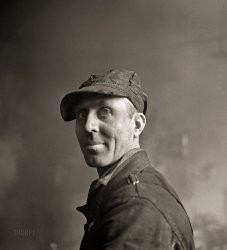
- Maine Train: 1940
- ... Aroostook, retired in 1956.
(The Gallery, Jack Delano, Railroads, Small Towns) ... Posted by Dave - 11/01/2022 - 12:27pm -
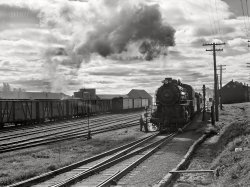
- Second Home: 1943
- ... started dying off probably by the 1950s when most large railroads and the unions agreed to use "pooled" cabooses where the caboose ... the lower left door window?
(The Gallery, Jack Delano, Railroads) ... Posted by Dave - 07/08/2014 - 12:39pm -
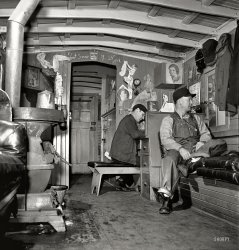
- L.A. Alley: 1936
- ... dime.
(The Gallery, Dorothea Lange, Kids, Los Angeles, Railroads) ... Posted by Dave - 10/20/2022 - 9:07pm -
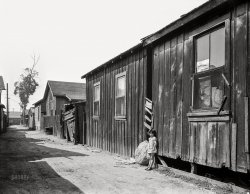
- West Chunk: 1900
- ... Express Company. This was done on 1918 to make sure the railroads and the freight carriers would run smoothly during our participation ... right is the PRR's Bel Del branch.
(The Gallery, DPC, Railroads) ... Posted by Dave - 08/05/2012 - 3:14pm -
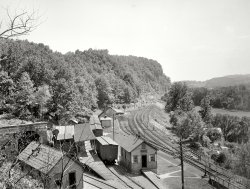
- Family Trip: 1939
- ... like this to climb aboard. Why not? It's not like the railroads were losing any money by hauling people in an otherwise empty boxcar. ... it.
(The Gallery, Dorothea Lange, Great Depression, Railroads) ... Posted by Dave - 03/02/2012 - 10:41pm -
![Family Trip: 1939 August 1939. Agricultural migrants. "Family who traveled by freight train. Toppenish, Washington. Yakima Valley." View full size. Medium-format nitrate negative by Dorothea Lange for the Farm Security Administration.
Can we assume...the young child on the right is the "feeling low" Ms. Toppenish captured by Dorothea before or after this photo?
Denny Gill
Chugiak, Alaska
Migrant FamilyI was born in the month and year this photo was taken. While my family was by no means affluent, we had it good compared to this family and countless others across the country. We had a roof over our heads, coal to heat, and food on the table. It's humbling to see photos like this.
Despite the hard times this family is evidently experiencing, the little boy seems perfectly content. He's found a stick to play with, like little boys do.
His mother, on the other hand, seems to be thinking, "What will we feed these children tonight?"
Re: My GrandfatherGood for your grandfather! If I had been running the train, I would have stopped the engine to allow a family like this to climb aboard. Why not? It's not like the railroads were losing any money by hauling people in an otherwise empty boxcar. Liability issues, no doubt. But would any of these people have been likely to hire a lawyer and file a lawsuit?
Look at the trains in India: wall-to-wall people, sitting atop the cars, hanging out the windows and off the sides.
"May I see your ticket, please?" No way.
I was also born in 1939, andI was also born in 1939, and raised by an almost-illiterate widow. She made good use of her "widow's mite' however, so that we had a modest house, an old car, food at mealtimes, and heat (one of my chores as an adolescent and teen was fire-tender). While we had no books, magazines, or newspapers in the house, I was nevertheless encouraged constantly to go to school and get as much out of it as I could. While she might be disappointed that I never quite got the bachelor's degree, she would be delighted if she could know the level of affluence I have reached today.
How does this relate? Well, one wonders to what extent this picture shows the result of bad luck or whether it is due to poor choices.
Shoes Don't MatchLook at Dad's shoes - a mixed pair, I think. They may not have been a good fit; he's letting his dogs breathe without them.
RE: "poor choices" - the U. S. unemployment rate in 1939 was 17.3%, compared to about 5% today. Maybe their "poor choice" wasn't a choice at all, but simply because they were part of that unfortunate 17.3%. It would take almost two years from the day this photo was taken for the wartime economy and the draft brought the U.S. economy to almost full employment.
[Below, a comparison of styles then and now. - Dave]
My GrandfatherWas a migrant farm worker when he was in his teens in the early 30's. He (somehow) convinced the Chicago, Rock Island, and Pacific Railroad to hire him on as a fireman in 1936 on his 18th birthday.
He always refused to throw hobos off the train and during the cold winters of Illinois and Missouri he'd let women and children have his seatbox in the cab, he often received demerits for his humane treatment of those he only recently rose above.
Optical IllusionI think I was mistaken. Dad's shoes are a pair. I guess it's all a matter or perspective.
Goober Pea
The KidWhile it can be a tough call, the child on the right appears to be a boy, no? And the wingtips in Feeling Low do not match the plain shoes in Family Trip, fwiw...
MotherI think that generally mother here is the only person that's not content with the situation. I also think she was the only person here who didn't want this photo to be taken.
MoralsThe father at least didn't abandon the family and set off on his own. Could we say the same for families today. No, I think either the mother would dump the guy and go on welfare or the guy would run off to start a new life. This shows how family morals have changed over the last 75 years.
I'd stop the engineMy Father-in-law came from a "RR" family and from the way he described it you would not stop if you wanted to keep your job.
It took 30 years of service to earn a pension, you could get 26/28 years no problem, it was the last 3or4 that were very hard. He said they watched you like a hawk any misstep and you were fired ,so no I don't think you would stop.
Riding the rails...My grandfather was part of an obscure local railroad -- Indianapolis Union Belt, which eventually became part of Conrail. Back in those days, jobs were hard to come by and they followed the rulebook quite seriously. The "bulls," as he called the railroad police, were notoriously cruel to hobos and to people who had a soft spot for them. They were a clique that didn't hang out with the rest of the workers.
Hard Travellin': The Hobo and His HistoryI recently read "Hard Travellin': The Hobo and His History" by Kenneth Allsop. Anyone interested in the story of homelessness, migrant workers, hoboing, the roots of the labour movements, etc., should read it.
(The Gallery, Dorothea Lange, Great Depression, Railroads)](https://www.shorpy.com/files/images/8b34311u_3.thumbnail.jpg)
- Pabst Backward: 1943
- ... few.
(The Gallery, Kodachromes, Chicago, Jack Delano, Railroads) ... Posted by Dave - 06/14/2017 - 11:51am -
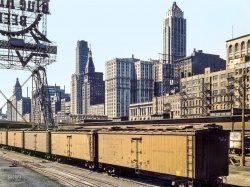
- Military R.R.: 1865
- ... their adult years, they saw the rise of well-established railroads that could travel fifty miles per hour. This, together with the ... http://usmrr.blogspot.com
(The Gallery, Civil War, Railroads) ... Posted by Dave - 08/01/2012 - 8:53pm -
![Military R.R.: 1865 City Point, Virginia, circa 1865. "Gen. J.C. Robinson" and other locomotives of the U.S. Military Railroad. From views of the main Eastern theater of war, the siege of Petersburg, June 1864-April 1865. Wet plate glass negative. View full size.
Robinson ahead by a nose Seems that the Lt. Genl. Grant is running a close second. The named locomotives are from the Wm. Mason Machine Works in Taunton, Mass. The engine ahead of both seems unnamed. Might be an "American" locomotive or a Wm. Mason.
LocationThe terrain and the enormity of the facilities in place makes me almost certain that this was taken at City Point, Virginia, the Union's main supply depot for the area at the time.
[Another clue would be the first three words of the caption. - Dave]
Who's DrivingThe engineer is definitely not Buster Keaton.
Any ideawhat the black things are in the upper right hand portion of the picture? When I looked at the blown up picture it looked a little bit like a lot of black socks hanging on a clothesline but that's obviously incorrect.
[It's a scratch in the emulsion. - Dave]
A bigger nameHard for me to see, but appears to be "Lt Gen. US Grant" on loco behind the Robinson machine. I am amazed at the hillside, ships and living conditions of the period.
Grant's Iron HorseSaturday we saw Grant's horse "Cincinnati;" today we see Grant's Iron Horse, "Lt. Genl. Grant," on the left.
Union IroncladA turret of a Union ironclad can be seen in the background over the top of the pier-side warehouse. This could be the USS Onondaga, which was stationed at City Point to prevent Confederate ironclads from breaking out of the James River and attacking the supply base. The problem is that the USS Onondaga had two turrets and I only see one.
Grant and Lee There is a photo so similar to this one in the book "Grant and Lee" by William A. Frassanito that it must have been taken about the same time. It is in the City Point chapter view 8. The tents and buildings on top of the bluff were part of the Railroad Hospital. The wharf shown is a replacement for one that was blown up by saboteurs on August 9,1864. The explosion killed 43 laborers and according to Mr. Frassanito narrowly missed General Grant who was in front of his headquarters tent at the time. His books have photos taken during the Civil War and then the same scene in modern times.
IroncladIn regard to the comment by Excel08 about the ironclad. Also according to Mr. Frassanito there would be about 200 vessels anchored off of City Point on any given day by the fall of 1864 including the ironclad ram "Atlanta" with one stack.
Poor LightingAmazing that all the headlights on these locomotives were a kerosene lamp in a box with a magnifying lens.
Spectre-visionNifty ghost in front of main tent!
Hillside erosionAttention troopers!
Gen. Grant has authorized the issuing of hazard pay due to the hillside erosion and the location of the outhouse.
It is further recommended that only those soldiers who know how to swim should make use of the facilitiesafter dark.
Buster Isn't ThereI'll bet he is out visiting Annabelle Lee.
InterestingAlmost as interesting as the locomotives are the view of the ships in the harbor.
OopsHow did I not see that? Boy, is that embarrassing.
Hey youget back to work.
25 years of progressIt amazes me to think that these beautifully turned out engines are only one generation away from the dawn of American railroading (think Tom Thumb and iron-plated wooden tracks). A person born in 1820 grew up with horse, foot or canal-boat travel, when 50 miles was a good day's journey. During their adult years, they saw the rise of well-established railroads that could travel fifty miles per hour. This, together with the telegraph, was the dawn of the "shrinking world."
The Third LocomotiveThe locomotive moving forward between the "Lt. Genl. Grant" and the "Genl. J.C. Robinson" is the "Governor Nye." This 4-4-0 was built by the Richard Norris & Son locomotive works in Philadelphia, and was acquired new by the USMRR on February 18, 1863. Sent to North Carolina in 1865 to work on the USMRR, it was still in the USMRR inventory in April 1866. Another photo taken within minutes of this one shows it in the yard.
Watch that last step...I don't think that cliff-side staircase meets any imaginable safety regulation.
Bridge Of Beanpoples & Cornstalks General J.C. Robinson 4-4-0 (Construction # 124) Formerly known as the USMRR locomotive General Haupt and acquired new by USMRR on January 17, 1863. Renamed General J.C. Robinson. Sold to the Baltimore & Ohio Railroad in 1865.
http://www.nvcc.edu/home/csiegel/USMRR%20Locomotives.htm
"That Man Haupt has built a bridge over Potomac Creek, about 400 feet long and nearly 100 feet high, over which loaded trains are running every hour, and upon my word gentlemen, there is nothing in it but beanpoles and cornstalks."
Monitor identityThe monitor noted by others is most likely a Passaic-class ship and probably the Lehigh. The primary assumption is that the ship is perpendicular to the line of sight (as are the other ships). In that case comparing the monitor's funnel (tall thin light-colored tube to the left of the turret) to the turret, they are signifiicantly closer spaced than would be the funnel-turret distance for a Canonicus-class ship, the only other type which fits what is visible. This marks it as a Passaic. To identify it as the Lehigh is the stretch. At least three Passaics were known to have been in the City Point area at this time; the Lehigh, Patapsco, and Sangamon. The Patapsco and Sangamon were both confusingly identified as having a white ring at the top of the turret/base of the rifle shield. There is no ring visible on the turret of this monitor. The Lehigh was all black.
O Scale model Civil War model railroadBernie Kempenski is building a model railroad with these kinds of locomotives, etc. His is dated 1862. http://usmrr.blogspot.com
(The Gallery, Civil War, Railroads)](https://www.shorpy.com/files/images/01859a_0.thumbnail.jpg)
- Proviso Perspective: 1943
- ...
(The Gallery, Kodachromes, Chicago, Jack Delano, Railroads) ... Posted by Dave - 06/28/2022 - 4:50pm -
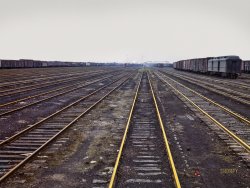
- Crescent Limited: 1926
- ... between 1920 and 1940 they were in use by 21 American railroads (and many more overseas) -The Canadian Pacific was its second most user. Various railroads built these in their own shops and called them by assorted names, but ... Posted by Dave - 07/13/2013 - 9:42pm -
![Crescent Limited: 1926 Alexandria, Virginia, circa 1926. "American Locomotive Co. -- Southern R.R. Crescent Limited 1396." Seen here from the other side, with more info in the comments. National Photo Company Collection glass negative. View full size.
So little stock, so high the rentHow much would the shoes have been to pay the rent? It doesn't look like a high volume place and the selection is very small.
[Probably didn't even make enough to pay for the coal. But at least they could move to a new location easily enough. -tterrace]
OOPs: Intended for the 'Juvenile Footwear'.
Daily CrescentAmtrak still operates the Crescent on a daily basis between New York City and New Orleans. It's even slightly quicker now. When the service was inaugurated in 1926, the journey from Washington to New Orleans required 33 hrs and 55 minutes. Today, thanks to 87 years of innovation and investment, the trip will only take you 26 hrs and 2 minutes!
Washington Post, May 7, 1933.
Crescent Limited Sets Up Records
Running on a faster schedule than in any previous year, the Crescent Limited, ace of the Southern Railway System's passenger train service between New York, Washington, Atlanta and New Orleans, broke all records for on-time performance in the year ended April 25, 1933, the eighth of its operation.
Out of the 365 trips in each direction the Crescent Limited reached Atlanta on time southbound on 360 days, or 98.6 percent, and reached Washington on time northbound on 357 days, or 97.9 percent. This brought the on-time performance for eight years up to 98.3 percent southbound and 96.4 percent northbound. On April 25 the Crescent Limited was placed on a schedule of 15 hours and 5 minutes between Atlanta and Washington, 20 hours and 10 minutes between Atlanta and New Your, and hour having been cut from the running time in each direction between Atlanta and Washington.
The Crescent limited is operated over the Pennsylvania Railroad between New York and Washington, the Southern between Washington and Atlanta, the West Point Route between Atlanta and Montgomery and the Louisville & Nashville between Montgomery and New Orleans.
SmileThat's one happy locomotive.
The "Hudson"The first 4-6-4 in America was built for the New York Central by ALCO and named after the river it ran. It proved it be such a popular configuration between 1920 and 1940 they were in use by 21 American railroads (and many more overseas) -The Canadian Pacific was its second most user. Various railroads built these in their own shops and called them by assorted names, but Hudson prevails. In their day they set two speed records. However, in the '40's the clear superiority of the diesel sent these to the scrap yards. A great steam engine; pulled the 20th Century Limited in its day.
This locomotivewas painted green.
It's beautiful!Most engines, at least this side of the water, were very much 'cleaner' in appearance than the Hudson ... but this engine appears to proclaim to the world that it is a very tough and powerful machine. To my eyes, it looks wonderful ... an amazing array of 'stuff' and 'things' just hung on the outside of the locomotive, all of it going to make this one purposeful-looking machine. And, presumably, maintenance was easier.
As for those punctuality rates; they make UK rates today look pretty poor, despite ultra-modern electric traction, computers, and the like. The people who operated the services all those years ago were evidently made of the 'right stuff'. How things have ... progressed.
PacificThe previous post regarding the "Hudson" class of locomotive on the NYC are effectively correct including the mention of the "20th Century Limited being pulled by the "Hudson" type 4-6-4 locomotive. The locomotive in this image however is a 4-6-2 "Pacific" from the Southern Railway and called a Ps-4. Its sister locomotive No. 1401 sits in the Smithsonian. They were painted a stunning green with gold trim. Some of the most beautiful locomotives on US rails.
Painted Green...I am not sure if the Smithsonian has the locomotive painted correctly but my comment for Shorpy's other side of the locomotive image shows that they have it depicted with green trim and the rest is gray. Here is my comment and my image from the Smithsonian.
Cylinder behind the bell?As handsome a machine as I have seen.
I can identify most of the systems here, but the cross ways cylinder between the bell and the smoke vent has me stumped. A lot of complexity there, it must be a worthwhile bit of steam technology. Who can say what it is?
Elesco FWH/paint scheme.The appliance between the bell and the smokestack is an Elesco feedwater heater. It uses exhaust steam from the loco's cylinders to pre-heat the feedwater going into the boiler. The cylindrical part is the heater bundle, and the feedwater pump is the appliance visible just above the rear coupled wheel.
1401 in the Smithsonian is in the correct paint scheme, which is largely green - inspired by the livery of the Southern Railway in Britain. The grey mentioned is representative of the graphite and oil-based finish typically applied to loco smokeboxes and often fireboxes on US railroads. The smokebox was usually unlagged, and so the external surfaces got quite hot when the engine was in steam. Normal paint would quickly burn off, so graphite used instead.
That cylindrical applianceis a Feedwater Heater. An Elesco Feedwater Heater to be precise. Made by Locomotive Superheater Company (hence the name L-S-CO), it used steam to preheat the water before being injected into the boiler so as to reduce the total energy needed to bring it to a violent boil at 200 psi. There were a number of Feedwater Heater manufacturers, the Elesco and Coffin types being the most easily identified because of their most common location on top of the smokebox between the smokebox front and stack (or smokestack).
Pole pocketWhat is strange to see on a mainline flyer are the pole pockets at the front just above the first wheel. In local service it sometimes was necessary to shove a car on an adjacent track using a long wooden pole socketed into this pocket and into a similar pocket on the car to be shoved. A dangerous practice that could result in serious injury when the pole snapped.
Pilot beam casting with poling pockets.The pilot beams on most modern US locos were a proprietary casting made by Commonwealth Steel, later known as General Steel Castings, of Granite City Illinois. The poling pockets were a standard feature of the casting, and can be seen on most locos, whether they were for passenger, freight or switching service.
Crescent was a class actIn 1977, I made a train trip with 3 children from Benson AZ to Augusta GA. Our "heritage fleet" Amtrak sleeper was dropped in New Orleans to be picked up by the next day's Southern Crescent. The Amtrak car's air conditioning quit and, as the temperature rose, the elderly Southern conductor sent an equally ancient porter to move us to another car. As we stepped into the coolness, I blurted out, "Hey, the air conditioning works." The old black porter put down the bags, turned to me and standing stiffly erect, said, "Suh, this is a Southrun cah. EVERTHING WORKS!"
Formal steam engine portraitsrequired that the side rods be in the "down" position,
witnessed by this photo of 1396.
Take a look at any steam locomotive builders photos; you will see all photos are made with the rods down.
Thanks to those who corrected some who mistakenly referred to this as a "Hudson" 4-6-4 engine type. These beauties were 4-6-2 "Pacific" class locomotives arguably the most ubiquitous steam locomotive type ever to run on the world's railways.
The Canadian Pacific ran both light small pacifics
and heavier more powerful ones until the end of steam.
I would imagine many other roads did too.
(The Gallery, D.C., Natl Photo, Railroads)](https://www.shorpy.com/files/images/SHORPY_32807u.thumbnail.jpg)
- Johnnie X: 1908
- ... as watermelon cars. Cars from ACL and other Southeastern railroads were used to ship watermelons to Northern cities like Chicago.
... 1880. These ventilated cars were mostly used by Southern railroads to carry produce to Northern cities.
You will note that the car ... Posted by Dave - 09/09/2008 - 12:35am -
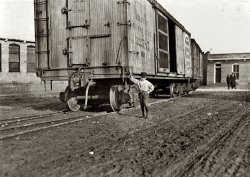
- Cincinnati: 1909
- ... Norfolk and Western and Louisville and Nashville Railroads. C&O passenger trains used the Central Union Depot and the 4th ...
(The Gallery, Boats & Bridges, Cincinnati Photos, DPC, Railroads) ... Posted by Dave - 07/29/2012 - 2:40pm -
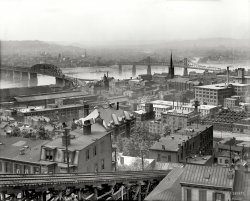
- Mike Evans: 1943
- ... hard-working man who gave his "all" to building the railroads and boring through mountains to build the rail tunnels in West ...
(The Gallery, Kodachromes, Chicago, Jack Delano, Railroads) ... Posted by Dave - 08/30/2012 - 4:44pm -
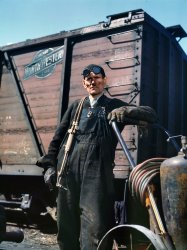
- Mechanical Nightmare
- ... put this in perspective, in the 1940s and 1950s American railroads were changing from steam to diesel power due to cost savings. The C ... a magazine or brochure.
(ShorpyBlog, Member Gallery, Railroads) ... Posted by Lost World - 07/26/2007 - 10:38am -
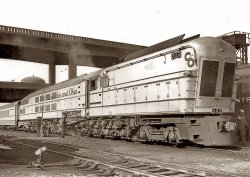
- Locomotive Dreams: 1942
- ...
(The Gallery, Kodachromes, Chicago, Jack Delano, Railroads) ... Posted by Dave - 07/24/2012 - 11:29pm -
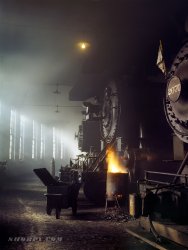
- Santa Fe Diesel: 1943
- ... about them.
Engine Colour It wasn't unusual for railroads to have different paint schemes for their freight and passenger ... (The Gallery, Kodachromes, Jack Delano, Railroads) ... Posted by Dave - 07/17/2012 - 10:08pm -
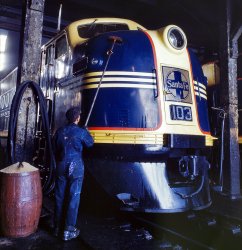
- 4 Seconds Fast: 1943
- ... and Train Order) system of train operation used by railroads for over a century, timing was critical to keep trains from running ...
Standard Time Zones Were initially set up by the railroads. Before that each city or region could set its own time and that ... Posted by Dave - 05/01/2014 - 1:27pm -
![4 Seconds Fast: 1943 March 1943. More Marceline, Missouri. "A dispatcher at work in the Atchison, Topeka & Santa Fe Railroad offices." This fellow would seem to be sensitive to glare. Photo by Jack Delano for the Office of War Information. View full size.
FastThe clock says it's four second fast. I wonder how they (a) know and (b) at what point do they correct it?
Walt DisneyThe Marceline depot is now the Walt Disney Hometown Museum.
http://www.waltdisneymuseum.org/museum/
Judging by the window (double hung sash with a small transom), I would say that it is indeed the same building.
Standard TimeUnder the TT&TO (Timetable and Train Order) system of train operation used by railroads for over a century, timing was critical to keep trains from running into one another. Every railroad had one very accurate "Standard Clock". Every employee whose duties were affected by the TT&TO Rules had to carry a railroad watch, certified annually by an approved jeweler to be accurate to not vary more than 30 seconds per week. Each employee starting on duty was required to compare his watch to a local standard clock at that station, and if it varied more than 30 seconds from the standard to correct it. Each station, the local standard clock had to be compared by telephone or telegraph to the Standard Clock, and if it varied by more than 30 seconds it had to be corrected.
I have that picture on the wall in my hallway!My parents had the picture of the hunting dog (along with three others, forming a set) for as long as I can remember, until they gave them to me back in 1992. I've had them on the wall in my house ever since. One, sadly, was damaged ten years ago when the 1930s era frame simply fell apart suddenly and it crashed down, smashing the glass and slicing the print. The others are still hanging on the wall in our hallway.
Standard Time ZonesWere initially set up by the railroads. Before that each city or region could set its own time and that caused chaos with railroad schedules, and safety.
Housekeeper's holidayBased on this photo, the feather duster must have been invented in 1944.
What gives? It appears as if some major changes were made in this office during March of 1943. Comparing the current image with the previous, we see: 1) the telegraph key has either been moved or eliminated, 2) “Mission Control” has the desk lamp over what appears to be a speaker device missing in “4 Seconds Fast: 1943,” 3) the standard clock is on one wall first, then another subsequently, and 4) in “4 Seconds” the dispatcher has what I’m guessing is a CTC board in front of him, absent in “Mission.” The one comforting constant is the sacred train sheet, spread from one end of the desk to the other. (Well, not so sacred anymore, as train movements are recorded and stored by computer software these days, not pen and ink…at least on Class 1 railroads.)
[The two pictures were taken within minutes of each other, and nothing has moved except the photographer. These are two different desks. - Dave]
Okay Dave, that makes sense. But your answer only raises two more questions: 1) why are there two desks for the same territory (a sure prescription for disaster), and 2) why does the "Mission" board go to Chicago from left to right, and the "4 Second" board go Kansas City (?) to Chicago right to left?
Face to FaceDave - your comment about being different desks is correct. In fact, they appear to be facing each other. Note the position and shape of the "poster board" tied to the pipe above them.
RE: left to right and right to left"why does the "Mission" board go to Chicago from left to right, and the "4 Second" board go Kansas City (?) to Chicago right to left?"
I would guess that "4 Seconds Fast" guy is seated facing south with Chicago to his left and "Mission Control" guy is facing north.
(Technology, The Gallery, Jack Delano, Railroads)](https://www.shorpy.com/files/images/SHORPY_8d26441u.thumbnail.jpg)
- Near Normal: 1900
- ... curvature may be too severe for the escalating speeds that railroads were beginning to see. Realigning was sometimes done to gain grade ... bar trucks Arch bar trucks were legal on interchange railroads until 1940, but they had been being phased out for decades before ... Posted by Dave - 10/09/2015 - 12:43pm -
![Near Normal: 1900 Circa 1900. "Track to be straightened. Normal, Ill's." 8x10 inch dry plate glass negative, Detroit Photographic Company. View full size.
StraighteningThe straightening spoken of is probably just that. The curvature may be too severe for the escalating speeds that railroads were beginning to see. Realigning was sometimes done to gain grade improvements as well. The derail probably remained if cars were still left on that track if they could endanger the main line.
Air BrakesThe car in the background by the platform does have air brakes, as evidenced by the presence of a brake hose dangling to the right of the coupler. The car in the left foreground does not appear to have air brakes.
The air brake in its present form was introduce in 1869, but there was no requirement that they be installed on all cars. Cars without air brake equipment were run at the rear of the train so that the cars with the equipment could be strung together at the front of the train under the control of the engineer. If the engineer needed more braking force than could be provided the equipped cars alone, whistle signals advised the conductor and rear trainman to walk to the top of the train setting handbrakes.
The type of control valves in use by 1900 were only reliable for trains up to about 20 cars, so frequently longer trains were run with the air hoses connected on only the front portion of the train and the remainder of the train was still controlled by handbrakes as described above. These were called "part air" trains.
Improvements to brake valves introduced in 1906 allowed longer trains, with up to 40 cars controlled by air brakes. The type AB brake valve on cars, introduced in 1933, permitted reliable control of a train with air of up to 150 cars, and part air trains disappeared shortly after that.
Arch bar trucksArch bar trucks were legal on interchange railroads until 1940, but they had been being phased out for decades before that.
They were used a lot longer than that on non-interchange lines like the SP narrow gauge -- one of the boxcars in our collection (SP 10) was still in service on the Inyo-Kern SP in 1960. Southern Pacific Boxcar 10 Repack Date This wooden Carter built boxcar was originally built in 1880. It is still sitting on trucks on our track in Fremont, CA. It could be one of the longest 'in service' box cars in the world--hard to say though.
LocationMile post C124, must be 124 miles to Chicago, Ill.
Rail to be straightened.The rail to be straightened reference you mentioned is a derail and is controlled by rodwork from either a tower in back of the photographer or the depot building.
Interesting bit of trackworkThere is a derail built into the rail closest to the viewer. It is controlled by the rods along side the track. Its purpose was to prevent runaway cars from fouling the main line. Seldom seen in the modern era.
Interesting scene.Archbar trucks were legal for many years after this photo. Interesting details here: note the grain door in the boxcar at left; also the point derail in foreground and dwarf signal operated by pipe rodding from a tower behind the photographer.
Another detail is the home signal on the gantry ... it is two-position with only red and white colors, which was standard on most railroads until a few years later. The signal is operated with long wires, which you can see alongside the pipe rodding in foreground.
Old CarsI know steam locomotives, not cars, but these seem a bit outdated even for 1900. They look at best 1880's vintage, though they've obviously been well maintained. This is along the Chicago & Alton route between Chicago and St. Louis.
Archbar trucks and brakewheelsDefinitely a transition era-- the wooden box cars have archbar trucks with wooden bolsters; journal boxes with babbit metal bearings; body hung brakes with no signs of airbrakes, but they have Janney knuckle couplers.
Can you image being a brakeman on these boxcars? Having to run on the roofwalk and jump between cars to turn the brakewheels to stop or slow these cars. yikes.
If it wasn't labeled "Normal [Ill.]I might have placed the scene in Peculiar, Mo.
(The Gallery, DPC, Railroads)](https://www.shorpy.com/files/images/SHORPY-4a20206a.thumbnail.jpg)
- Washington Union Station: 1912
- ... was not the devil.
(Panoramas, D.C., Natl Photo, Railroads) ... Posted by Dave - 12/10/2022 - 9:24pm -
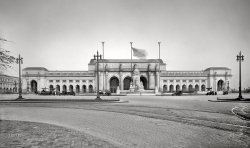
- The Kodachrome Hills: 1942
- ... of the rail car.
Crane cars are hardly uncommon. Most railroads have a wreck train on call at division points in the event of serious ... Wheel.
(The Gallery, Kodachromes, John Vachon, Mining, Railroads) ... Posted by Dave - 08/30/2012 - 1:58pm -
![The Kodachrome Hills: 1942 May 1943. "Nearly exhausted sulfur vat from which railroad cars are loaded. Freeport Sulphur Company at Hoskins Mound, Texas." View full size. 4x5 Kodachrome transparency by John Vachon, Office of War Information.
CraneInteresting. A crane on the rails. Was it attached to a rail car of some sort?
CraneBrent, Thanks for taking the time to explain.
SulfurWhen I was a small child in Galveston, there would be scores of gondola cars on the same train, full of sulfur. Likely mined somewhere like this.
[This is where they stored the sulfur after it was extracted. - Dave]
Re: Crane"Interesting. A crane on the rails. Was it attached to a rail car of some sort?"
If you look at the full size version of the picture you can see that the crane is part of a rail car. It is turned sideways to handle the sulfur which is why the back end sticks out over the sides of the rail car.
Crane cars are hardly uncommon. Most railroads have a wreck train on call at division points in the event of serious derailments and those trains invariably include a crane. For an industry like this where they are using trains to move product out of the pit a steam crane mounted on a railroad car is just about ideal - mobile and doesn't require extra space to move in. These days of course most open pit mines don't use rails to move product out but truck that would make your basic monster truck look like a Hot Wheel.
(The Gallery, Kodachromes, John Vachon, Mining, Railroads)](https://www.shorpy.com/files/images/1a35438u.thumbnail.jpg)
- Cajon Pass: 1943
- ...
(The Gallery, Kodachromes, Jack Delano, Landscapes, Railroads) ... Posted by Dave - 08/03/2012 - 11:33am -
